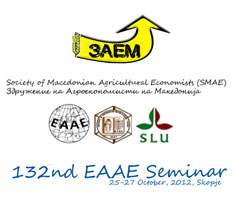About Faculty  Science and Application
Science and Application  Determination of total polyphenol content and analysis of antioxidant activity of onion extract
Determination of total polyphenol content and analysis of antioxidant activity of onion extract
 Science and Application
Science and Application  Determination of total polyphenol content and analysis of antioxidant activity of onion extract
Determination of total polyphenol content and analysis of antioxidant activity of onion extract | Determination of total polyphenol content and analysis of antioxidant activity of onion extract | | Print | |
|
TITLE:
Determination of total polyphenol content
and analysis of antioxidant activity of onion extracts
PRINCIPAL RESEARCHER: Prof. Dr. Mirjana S. Jankulovska
Summary
In recent years
there has been great interest in the functional properties of fruits and
vegetables, as well as their contribution to human health. Fruits and
vegetables are source of many useful nutrients, among which polyphenols play an
important role. Polyphenols are organic compounds that are naturally present in
plant foods. They are antioxidants, i.e. they bind free radicals that damage
cells and increase the risk of various diseases. Consumption of foods rich in
polyphenols is of great importance, because it contributes to the prevention of
various diseases. Researchers and food processors are increasingly interested
in identifying and determining polyphenols in fresh and processed foods.
One of the richest sources of polyphenols in the human diet is the
onion (Allium cepa L.). It is one of
the oldest cultivated vegetables in the world, the second most produced
vegetable after tomatoes. Flavonols such as quercetin and its derivatives are
more common in onion varieties with yellow or brown husks, while anthocyanins
that contribute to the purplish-red color are more common in varieties with red
husks. According to the data from the literature, the presence of polyphenols
is greater in the enveloping shells of onions. Therefore, research on the
reduction of onion waste, which can be solved by using the enveloping onion
peels in the diet, has been current lately.
Quantitative determination of polyphenols
is difficult due to the complexity of their structure and diversity. First a
suitable solvent for the extraction of polyphenols is selected, followed by a
quantitative determination of total polyphenols, flavonoids and antioxidant
activity. The most commonly used method for determining the content of total
polyphenols and flavonoids, as well as for determining the antioxidant activity
is UV-Vis spectroscopy. The determination of the content of total polyphenols
and flavonoids is performed according to different standards. In the research
of this project, gallic acid (3,5,7-trihydroxybenzoic acid) will be used as a
standard for determination of total polyphenols, while the content of
flavonoids will be determined in relation to quercetin
(3,3',4',5,7-pentahydroxy flavonoids). The antioxidant activity is based on the
use of the stable free radical 1,1-diphenyl-2-picrylhydrazyl (DPPH). For the
interpretation of the experimental data will use the parameter IC50 (IC -
inhibition capacity), i.e. concentration of the substrate which reduces the
activity of DPPH by 50 %.
|
| < Prev | Next > |
|---|
Choose Your Language/Избери јазик
Institutes
| CROP PRODUCTION |
| FRUIT GROWING, VITICULTURE AND ENOLOGY |
| ANIMAL BIOTECHNOLOGY |
| FOOD |
| ENVIRONMENT |
| PLANT PROTECTION AND AGRICULTURAL TECHNICS |
| AGRICULTURAL ECONOMICS |
Centers
| Career Center |
Laboratories
| Laboratory list |
Accreditation certificate
CERTIFICATE FOR ACCREDITATION NO. LT-о5о, to fulfill the standard MKC EN ISO / IEC 17025: 2006 Accreditation Certificate 2018
Accreditation Certificate 2018 Attachment to the certificate lt-050-2018
Attachment to the certificate lt-050-2018
We have 1 guest online
Poll
Links

|

|

|
|

|
Адреса Факултет за земјоделски науки и храна ул. „16-та Македонска Бригада“ бр.3 П. фах 297 1000 Скопје |
| УНИВЕРЗИТЕТ „Св. КИРИЛ И МЕТОДИЈ“ ВО СКОПЈЕ | УКИМ ЗЕМЈОДЕЛСКИ ИНСТИТУТ-СКОПЈЕ | СТУДЕНТСКИ ПАРЛАМЕНТ НА УНИВЕРЗИТЕТОТ | AGRICULTURAL POLICY PLUS - APP | ЗАЕМ | Тел: +389 2 3115277 Интернет адреса: www.fznh.ukim.edu.mk E-пошта: contact@fznh.ukim.edu.mk |
| СТУДЕНТСКИ ПРАВОБРАНИТЕЛ | |||||
| ЦИПОЗ |




